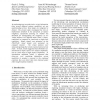Free Online Productivity Tools
i2Speak
i2Symbol
i2OCR
iTex2Img
iWeb2Print
iWeb2Shot
i2Type
iPdf2Split
iPdf2Merge
i2Bopomofo
i2Arabic
i2Style
i2Image
i2PDF
iLatex2Rtf
Sci2ools
HAPTICS
2003
IEEE
2003
IEEE
The Role of Multisensory Feedback in Haptic Surface Perception
In performing most everyday tasks, we use information from several different sensory modalities, yet our understanding of how these inputs are integrated is limited. The present study investigated the role of multisensory feedback in the perception of surface roughness, specifically focusing on whether the threshold for distinguishing the roughness of two virtual surfaces was different under visual + haptic conditions, as compared to visual-only or haptic-only conditions. Haptic stimuli were presented via the PHANToM; visual stimuli were presented via computer monitor. The virtual surfaces were sinusoidal gratings that varied in spatial period across trials. Overall, results suggested that threshold was determined by haptic input at low surface amplitudes, and by visual input at high surface amplitudes. At intermediate amplitude values, it appeared that observers were combining information across modalities to produce a percept in the combined condition that was better than that obtai...
| Added | 04 Jul 2010 |
| Updated | 04 Jul 2010 |
| Type | Conference |
| Year | 2003 |
| Where | HAPTICS |
| Authors | Gayla L. Poling, Janet M. Weisenberger, Thomas Kerwi |
Comments (0)

